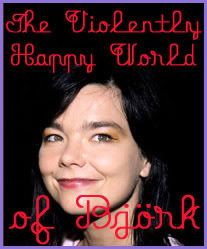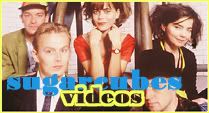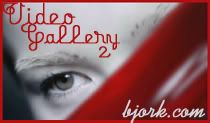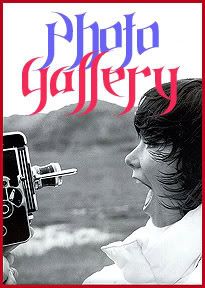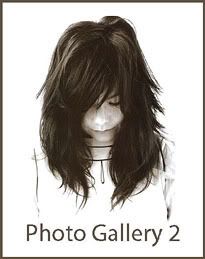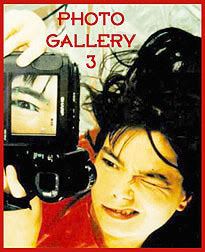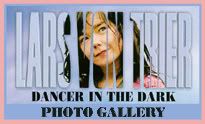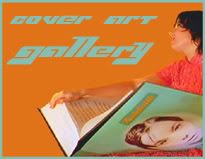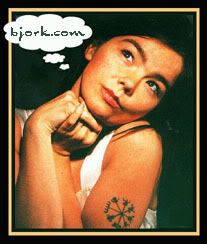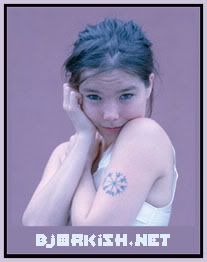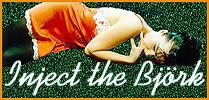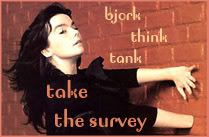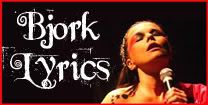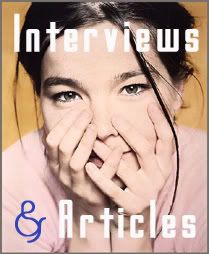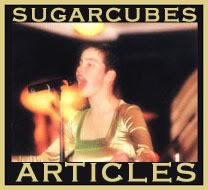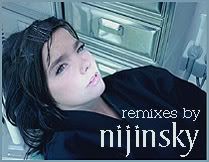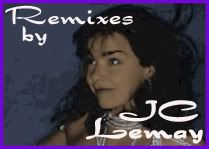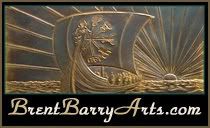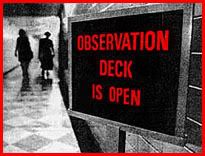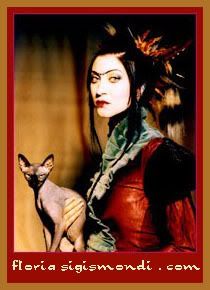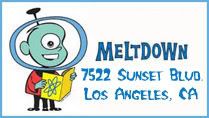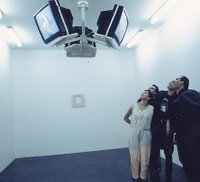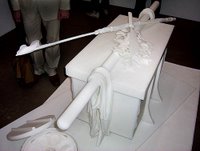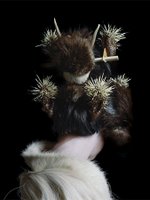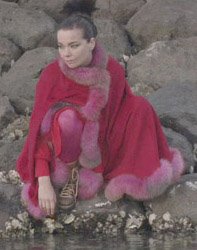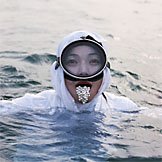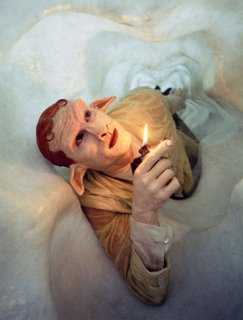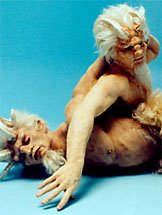Björk Zine – First Anniversary Issue!
by Mark Burbey
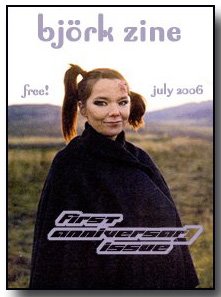 July 21st marks the one-year anniversary of Björk Zine, which I’m proud to say has over 600 hits to its credit. Inspired by various other Björk sites – Björk.com and Björkish, in particular – my goal with Björk Zine was to create something closer to a webzine than a website. I wanted it to be more like a magazine, and what I think distinguishes Björk Zine from other Björk sites is the bounty of interesting reading material, which I hope everyone is enjoying.
July 21st marks the one-year anniversary of Björk Zine, which I’m proud to say has over 600 hits to its credit. Inspired by various other Björk sites – Björk.com and Björkish, in particular – my goal with Björk Zine was to create something closer to a webzine than a website. I wanted it to be more like a magazine, and what I think distinguishes Björk Zine from other Björk sites is the bounty of interesting reading material, which I hope everyone is enjoying.
| Björk THANK YOU FOR DOING THIS INTERVIEW, I'M HONORED TO BE SHARING SOME TIME WITH YOU. Oh no, thank you! DID THEY TELL YOU THIS IS FOR A SKATEBOARD MAGAZINE? Yes, they just did! GOOD, BECAUSE I HAVE SOME SKATING QUESTIONS FOR YOU TO START WITH. YOU RECENTLY MADE A SONG USED IN THE "HOT CHOCOLATE" VIDEO (DURING THE CHOREOGRAPHED WHITE SHIRT SCENES) HOW DID THAT COME ALONG FOR YOU |
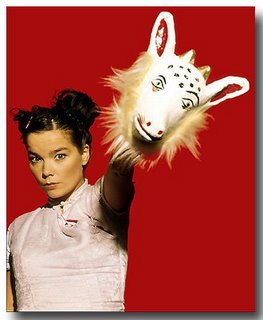 I was playing this tour last summer around the States and I got a message from my friend, Spike Jonze, saying "Is it ok if I come see your show on the guest list? It's me plus 17." I never get requests like that, so it was really funny. So I played the show, and with live shows you've got good ones and bad ones, and maybe that one wasn't one of the best, but afterwards we had all these tables and chairs outdoors. We had a little ghetto blaster and Drew from Matmos was Djing a little bit, and Spike and his 17 guests came to say hi. I met all the guys and it just became so much fun. Everybody started dancing, but it was really muddy there, so somebody dragged out a carpet they'd nicked from somewhere and put it over the mud. Everybody started breakdancing and inventing these stupid dances, and it ended up being 10 times funnier than the show. But I got introduced to all those skaters there, and then two months later I got an email from Spike wondering if I'd be up for doing a song for their video. I was really excited, like "Yeah, of course!" I was in the middle of making this new album and I was on this little island of the coast of
I was playing this tour last summer around the States and I got a message from my friend, Spike Jonze, saying "Is it ok if I come see your show on the guest list? It's me plus 17." I never get requests like that, so it was really funny. So I played the show, and with live shows you've got good ones and bad ones, and maybe that one wasn't one of the best, but afterwards we had all these tables and chairs outdoors. We had a little ghetto blaster and Drew from Matmos was Djing a little bit, and Spike and his 17 guests came to say hi. I met all the guys and it just became so much fun. Everybody started dancing, but it was really muddy there, so somebody dragged out a carpet they'd nicked from somewhere and put it over the mud. Everybody started breakdancing and inventing these stupid dances, and it ended up being 10 times funnier than the show. But I got introduced to all those skaters there, and then two months later I got an email from Spike wondering if I'd be up for doing a song for their video. I was really excited, like "Yeah, of course!" I was in the middle of making this new album and I was on this little island of the coast of
THE GUYS I TALKED TO WHO WERE ON THAT TOUR SAID THEY HAD THE BEST TIME WITH YOU, THAT IT WAS THE HIGHLIGHT OF THE TRIP. WERE YOU SURPRISED THAT SKATERS WERE INTO WHAT YOU DO, OR DID YOU ALREADY KNOW THAT? YOU'VE GOT QUITE A FOLLOWING IN SKATING.
I didn't have a clue, to be honest. It was really quite flattering to find out.
SO WITH THE NEW ALBUM, WHAT INSPIRED YOU TO DO AN ENTIRE ALBUM BASED ON VOCALS AND VOICES ALONE?
 I didn't start off thinking that was what I was going to do. I was just writing songs with instruments, but I'd listen to them and think "This isn't really good, is it?" I'd start muting certain things and it would sound better, so I thought maybe I'd just take more away and see what happened. It just kind of happened. Looking back on things, it's always easy to be wise afterwards, to sound clever, but it wasn't like that while I was doing it. I was just kind of tired of instruments, bored a bit, and I'd been backing with them a lot the last few albums, arranging for a huge orchestra – the VESPERTINE tour had 70 people on stage. It was kind of like "Fuck that!" and just let's do something completely different. There was one track where these German guys did a whole rave sounding track with just their voices and that really helped me see the possibilities. It wasn't like they were beat-boxing; these are really white Germans. It just cracked me up and seemed so fun. I was just into having fun with something new.
I didn't start off thinking that was what I was going to do. I was just writing songs with instruments, but I'd listen to them and think "This isn't really good, is it?" I'd start muting certain things and it would sound better, so I thought maybe I'd just take more away and see what happened. It just kind of happened. Looking back on things, it's always easy to be wise afterwards, to sound clever, but it wasn't like that while I was doing it. I was just kind of tired of instruments, bored a bit, and I'd been backing with them a lot the last few albums, arranging for a huge orchestra – the VESPERTINE tour had 70 people on stage. It was kind of like "Fuck that!" and just let's do something completely different. There was one track where these German guys did a whole rave sounding track with just their voices and that really helped me see the possibilities. It wasn't like they were beat-boxing; these are really white Germans. It just cracked me up and seemed so fun. I was just into having fun with something new.
ALL OF YOUR SOLO ALBUMS HAVE HAD SUCH A DISTINCT SOUND AND FEEL TO THEM HAVE YOU CONSCIOUSLY TRIED TO MAKE EACH ONE IT'S OWN LITTLE WORLD OR HAS IT BEEN A NATURAL PROGRESSION OF SOUND TO YOU?
Mostly it comes naturally. Part of me is very conservative, and obviously being a singer my voice is always going to be on the albums and sound the same and have the same person writing the lyrics, so there are so many things that are always going to be the same- which is great. I like being conservative in that way. But the other half of me becomes like a kid in a toy shop. One album I might say "Everything is going to be pink!" The next album I might say "Everything is going to be made of licorice!" Music should be adventurous. You're always going to be yourself, but you can enjoy different things. You can travel and make changes, and one minute you might be watching a comedy in the cinema and the next you might be at a funeral for a relative.
AND YOU JUST HAVE TO KEEP ROLLING WITH THINGS.
Yeah! And we're like that, we can adapt. Like you say, we can roll with it, so why not?
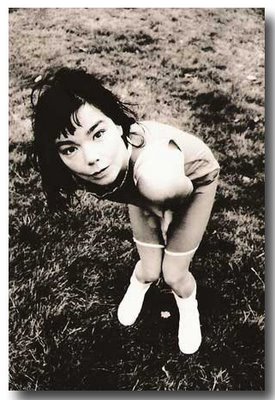 YOUR ALBUM ARTWORK AND YOUR VIDEOS HAVE ALWAYS BEEN BEAUTIFULLY DONE HOW DOES VISUAL ART AFFECT YOUR SONGS? DO YOU TRY TO MATCH THE SOUND WITH THE LOOK? DO YOU GET INSPIRATION FROM IT?
YOUR ALBUM ARTWORK AND YOUR VIDEOS HAVE ALWAYS BEEN BEAUTIFULLY DONE HOW DOES VISUAL ART AFFECT YOUR SONGS? DO YOU TRY TO MATCH THE SOUND WITH THE LOOK? DO YOU GET INSPIRATION FROM IT?
It's a bit of both. I get really excited when I see something visual that I like, but after seeing so many videos on MTV where you see the best video and hear the best song but they don't fit together at all, I decided to really go out of my way to make sure there is a connection between what you see and what you hear. I think that connection might be more important than either part on its own. The handshake is more important.
THERE HAVE BEEN SO MANY LYRICAL AND VISUAL REFERENCES TO ALL KINDS OF ANIMALS IN YOUR WORK- IF YOU COULD BE ANIMA, REAL OR NOT, WHAT WOULD YOU CHOOSE TO BE?
(Laughter) I love animals! I really like pandas. I think they're sexy, to be quite honest. I like so many though. I like fish and I like jellyfish – I think they're gorgeous. I really like plants a lot too. Do you know who David Attenborough is?
YES.
I really love his DVDs. I like to watch those nature documentaries a lot. I really enjoy them.
YOU HAVE SUCH A DEVOTED FAN BASE FROM ALL OVER THE PLANET. DO YOU FEEL LIKE A CITIZEN OF THE WHOLE WORLD NOW OR WILL YOU ALWAYS BE AN ICELANDER?
That's an interesting question. I think a bit of both. I still spend half my time in
YOU TALKED ABOUT SOME OF THE DIFFERENT VOCALISTS ON THE ALBUM. YOU WORKED WITH SOME REALLY INCREDIBLE PEOPLE FOR THIS ALBUM. IS THERE ANYBODY YOU WERE MOST EXCITED TO GET TOGETHER WITH?
It's impossible to pick because I chose them specifically for different reasons. First I worked with the throat singer, then with Tokaka from
DO YOU THINK YOU'LL DO MORE WITH IT?
Yeah, I'm learning about funny comedy noises and I just got really into yoddling! Fierce!
REALLY? HAVE YOU BEEN PRACTICING?
Not yet, but I can see some trips to the
HOW ARE YOU GOING TO WORK THESE SONGS INTO YOUR LIVE SHOWS?
Everybody involved seems to be up for it, so maybe they'll all come on the road. What I'd like to do is make another album like this and then tour for two of the at once.
HAVE YOU STARTED WORK ON ANOTHER ONE ALREADY?
I have. When you start exploring something, you open a box and all this stuff comes pouring out. You don't want to stop the flow if it.
I KNOW A LOT OF PEOPLE WHO HAVE GROWN UP LISTENING TO ALL THE MUSIC YOU'VE MADE'DO YOU
Oh yes, that'd be great, wouldn't it?!
